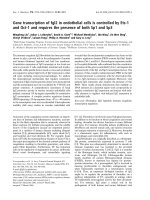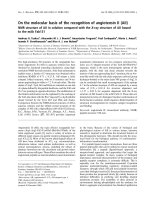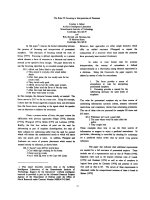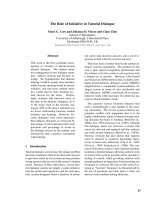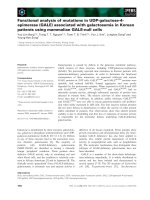Báo cáo khoa học: " Continuous infusion of ceftazidime in critically ill patients undergoing continuous venovenous haemodiafiltration: pharmacokinetic evaluation and dose recommendation" docx
Bạn đang xem bản rút gọn của tài liệu. Xem và tải ngay bản đầy đủ của tài liệu tại đây (168.2 KB, 7 trang )
Open Access
Available online />Page 1 of 7
(page number not for citation purposes)
Vol 10 No 1
Research
Continuous infusion of ceftazidime in critically ill patients
undergoing continuous venovenous haemodiafiltration:
pharmacokinetic evaluation and dose recommendation
Christophe Mariat
1
, Christophe Venet
2
, François Jehl
3
, Sandrine Mwewa
4
, Vesna Lazarevic
4
,
Eric Diconne
2
, Nathalie Fonsale
5
, Anne Carricajo
5
, Stéphane Guyomarc'h
2
, Régine Vermesch
2
,
Gérald Aubert
5
, Roselyne Bidault
4
, Jean-Claude Bertrand
2
and Fabrice Zeni
2
1
Service de Néphrologie, Hôpital Nord, CHU de Saint-Etienne, Saint-Etienne, France
2
Service d'Urgences et de Réanimation, Hôpital Bellevue, CHU de Saint-Etienne, St Etienne, France
3
Laboratoire de Bactériologie, Faculté de Médecine, Strasbourg, France
4
Unité de Pharmacologie Clinique, Laboratoire Glaxo Wellcome, Marly Le Roi, France
5
Service de Bactériologie, Hôpital Bellevue, CHU de Saint-Etienne, St Etienne France
Corresponding author: Christophe Mariat,
Received: 6 Oct 2005 Revisions requested: 15 Nov 2005 Revisions received: 12 Dec 2005 Accepted: 16 Jan 2006 Published: 13 Feb 2006
Critical Care 2006, 10:R26 (doi:10.1186/cc3993)
This article is online at: />© 2006 Mariat et al.; licensee BioMed Central Ltd.
This is an open access article distributed under the terms of the Creative Commons Attribution License ( />),
which permits unrestricted use, distribution, and reproduction in any medium, provided the original work is properly cited.
Abstract
Introduction In seriously infected patients with acute renal
failure and who require continuous renal replacement therapy,
data on continuous infusion of ceftazidime are lacking. Here we
analyzed the pharmacokinetics of ceftazidime administered by
continuous infusion in critically ill patients during continuous
venovenous haemodiafiltration (CVVHDF) in order to identify the
optimal dosage in this setting.
Method Seven critically ill patients were prospectively enrolled
in the study. CVVHDF was performed using a 0.6 m
2
AN69
high-flux membrane and with blood, dialysate and ultrafiltration
flow rates of 150 ml/min, 1 l/hour and 1.5 l/hour, respectively.
Based on a predicted haemodiafiltration clearance of 32.5 ml/
min, all patients received a 2 g loading dose of ceftazidime,
followed by a 3 g/day continuous infusion for 72 hours. Serum
samples were collected at 0, 3, 15 and 30 minutes and at 1, 2,
4, 6, 8, 12, 24, 36, 48 and 72 hours; dialysate/ultrafiltrate
samples were taken at 2, 8, 12, 24, 36 and 48 hours.
Ceftazidime concentrations in serum and dialysate/ultrafiltrate
were measured using high-performance liquid chromatography.
Results The mean (± standard deviation) elimination half-life,
volume of distribution, area under the concentration-time curve
from time 0 to 72 hours, and total clearance of ceftazidime were
4 ± 1 hours, 19 ± 6 l, 2514 ± 212 mg/h per l, and 62 ± 5 ml/
min, respectively. The mean serum ceftazidime steady-state
concentration was 33.5 mg/l (range 28.8–36.3 mg/l). CVVHDF
effectively removed continuously infused ceftazidime, with a
sieving coefficient and haemodiafiltration clearance of 0.81 ±
0.11 and 33.6 ± 4 mg/l, respectively.
Conclusion We conclude that a dosing regimen of 3 g/day
ceftazidime, by continuous infusion, following a 2 g loading
dose, results in serum concentrations more than four times the
minimum inhibitory concentration for all susceptible pathogens,
and we recommend this regimen in critically ill patients
undergoing CVVHDF.
Introduction
The β-lactam antibiotics are known to exhibit little concentra-
tion-dependent activity. The maximal killing rate occurs when
antibiotic concentrations have reached four to five times the
minimum inhibitory concentration (MIC) for the causative path-
ogens [1], and higher concentrations do not significantly
enhance the bactericidal activity. Conversely, an increase in
the time for which free β-lactam serum levels are above the
MIC is likely to improve antimicrobial activity. To optimize the
use of these so-called time-dependent antibiotics, shortening
the dose interval appears to be more critical than increasing
the dose. These pharmacodynamic considerations have led to
the proposition that continuous intravenous infusion may be
the best way to administer β-lactams to maintain serum levels
CRRT = continuous renal replacement therapy; CVVHDF = continuous venovenous haemodiafiltration; MIC = minimum inhibitory concentration.
Critical Care Vol 10 No 1 Mariat et al.
Page 2 of 7
(page number not for citation purposes)
above the target concentration throughout the course of ther-
apy [2-4].
Among β-lactams, ceftazidime is probably the most extensively
studied during continuous intravenous infusion [5-12].
Although the clinical benefits of such a regimen are not yet
definitely proven, ceftazidime tends to be widely administered
by continuous infusion. Ceftazidime is a third-generation
cephalosporin (molecular size 636.6 Da) with a broad spec-
trum of antibacterial activity (it is very active against Pseu-
domonas aeruginosa) and is commonly used in intensive care
units. In patients with normal renal function, about 90% of
ceftazidime is excreted unchanged by glomerular filtration
[13]. In the setting of renal impairment, its pharmacokinetic
profile is markedly altered and requires specific dosage adjust-
ment [14-16]. It is well established [17-20] that a large propor-
tion of administered ceftazidime is removed during continuous
renal replacement therapies (CRRTs) as well as conventional
haemodialysis, and the resulting pharmacokinetic modifica-
tions have been characterized in various patient groups,
including critically ill patients undergoing continuous haemofil-
tration or haemodiafiltration [21,22]. Of note, these data were
exclusively derived from studies in which ceftazidime was
administered by intermittent infusions, and thus the findings
cannot be extrapolated to continuous administration. The dos-
age for continuous infusion of ceftazidime required to achieve
optimal therapeutic concentrations in the setting of CRRT is
unknown. Our purpose was therefore to analyze the pharma-
cokinetics of ceftazidime administered by continuous infusion
in critically ill patients during continuous venovenous haemodi-
alfiltration (CVVHDF) and to identify the optimal dosage in this
population.
Materials and methods
Study population
This prospective open-label study was conducted in a 15-bed
intensive care unit of the teaching hospital of Saint-Etienne,
France. Patients meeting the following criteria were eligible for
inclusion in the study: age over 18 years; clinically suspected
or proven bacterial infection; isolated or expected causative
pathogen susceptible to ceftazidime; and acute renal failure
requiring CVVHDF. Exclusion criteria were known allergy to
ceftazidime or other β-lactams; use of ceftazidime within the
48 hours before enrollment; pregnancy, as determined by
serum β-human chorionic gonadtotrophin testing; and residual
glomerular filtration rate, measured by creatinine clearance,
over 10 ml/min. The study protocol and the consent document
were approved by the institutional review board, and written
informed consent was obtained from each patient or a legally
designated representative.
Continuous venovenous haemodiafiltration
CVVHDF was performed using the PRISMA machine (Hospal,
Meyzieu, France) equipped with a Multiflow 60 AN69HF 0.60
m
2
polyacrylonitrile hollow-fibre membrane. Vascular access
was obtained by introduction of a 12 French, 16 or 20 cm dou-
ble-lumen central venous catheter (Arrow, Reading, PA, USA)
into a femoral vein. For all patients, operational characteristics
of haemodialfiltration were set as follows: blood flow rate 150
ml/min; dialysate flow rate 1 l/hour; and ultrafiltration rate 1.5
l/hour. Substitution fluids were delivered according to a predi-
lutional mode with a flow rate allowing 100–150 ml/min net
ultrafiltration. Under this haemodiafiltration regimen, CVVHDF
clearance of ceftazidime was predicted to be 32.5 ml/min
[23].
Anticoagulation of the extracorporeal circuit was ordered at
the discretion of the attending physician. If a patient was
already undergoing CVVHDF, then the haemofilter was
changed before the patient's inclusion in the study.
Ceftazidime dosage and administration
After initiation of CVVHDF, all patients received a 2 g intrave-
nous loading dose of cefatzidime (GlaxoSmithKline, Marly-le-
Roi, France) infused over three minutes, via a central venous
catheter different from that used for CVVHDF, and immedi-
ately followed by a 3 g continuous infusion over 24 hours. The
ceftazidime dose was expected to provide serum antibiotic
concentrations between 30 and 40 mg/l, and was selected
according to the equation R
0
= CL
tot
× Css, where R
0
is the
continuous administration rate, Css is the steady-state serum
concentration of ceftazidime, and CL
tot
is the total clearance
of ceftazidime (estimated using the equation CL
tot
= 0.693 ×
[volume of distribution/elimination half-life]). We anticipated a
volume of distribution close to 0.30 l/kg based on data availa-
ble in intensive care patients [24], and hypothesized a half-life
of four hours, which is in keeping with the half-life found in a
recent study [21] that examined similar patients and reported
a haemofiltration clearance of ceftazidime in the same range as
our predicted haemodiafiltration clearance.
Ceftazidime was continuously infused by the means of syringe
infusion pump (Ivac Medical System, Basingstoke, UK) for at
least 72 hours. Syringes with freshly dissolved antibiotic, were
inserted every 16 hours. In case of CVVHDF clotting, the con-
tinuous infusion was stopped during change of haemofilter.
Sample collection and assay
Arterial blood samples (7 ml) were collected from a radial cath-
eter before the loading dose then at 3 (immediately after the 2
g bolus infusion), 15 and 30 minutes and at 1, 2, 4, 6, 8, 12,
24, 36, 48 and 72 hours. After collection, blood samples were
immediately centrifuged (2000 g for 10 minutes) and stored at
-80°C until analysis.
Seven samples (10 mL) were simultaneously drawn from the
dialysate/ultrafiltrate outlet before ceftazidime infusion and at
2, 8, 12, 24, 36 and 48 hours. After collection, dialysate/ultra-
filtrate samples were frozen and stored at -80°C until analysis.
The concentrations of ceftazidime in the serum and dialysate/
Available online />Page 3 of 7
(page number not for citation purposes)
ultrafiltrate were assayed by high-performance liquid chroma-
tography, employing the technique described by Jehl and cow-
orkers [25].
Within-day and between-day coefficients of variability were
both below 10% and the limit of quantification was 0.05 mg/l
for serum and 1.0 mg/l for dialysate.
Pharmacokinetic analysis
A noncompartmental model was applied. The following phar-
macokinetic parameters were determined for each patient.
The steady-state serum concentration of ceftazidime (mg/l)
was calculated as the mean of the serum concentrations
measured at 24, 36, 48 and 72 hours. The elimination half-life
(hours) was calculated as ln2/k
e
, where k
e
is the apparent ter-
minal elimination rate constant determined using least-squares
regression analysis. The area under the concentration-time
curve from time zero to 72 hours (mg/hour per l) was calcu-
lated using the linear trapezoidal summation method. The total
clearance (ml/min) was calculated as R
0
/steady-state serum
concentration of ceftazidime, where R
0
is the continuous
administration rate. Finally, the volume of distribution (l) was
calculated as D/C
0
, where D is the loading dose and C
0
the
serum concentration at the end of the bolus infusion.
In addition, the following CVVHDF parameters were assessed.
The sieving coefficient was calculated as C
D/UF
/C
S
, where C
D/
UF
is the dialysate/ultrafiltrate concentration of ceftazidime and
C
S
the time-corresponding serum concentration. The haemo-
diafiltration clearance (ml/min) was calculated as sieving coef-
ficient × combined dialysate/ultrafiltrate flow rate [26]. The
contribution (%) of haemodiafiltration clearance to total clear-
ance of ceftazidime was calculated as follows: (haemodiafiltra-
tion clearance/total clearance) × 100.
Statistical analysis
All calculations were made by programming pharmacokinetic
and CRRT clearance equations into Microsoft Excel
®
97
(Microsoft Corporation, Irvine, CA, USA). The same software
program was used to compute mean and standard deviations
for the various pharmacokinetic and haemodiafiltration param-
eters.
Results
Patient demographics
A total of seven patients were enrolled in the study from Octo-
ber 2000 to April 2002. All patients completed the scheduled
period of pharmacokinetic sampling. None of the patients
received ceftazidime before their enrollment in the study. The
demographic characteristics of the patients are summarized in
Table 1. The median time from admission to the intensive care
unit to inclusion in the study was 15 days (range 2–30 days).
All patients were male and were mechanically ventilated. They
all had a suspected diagnosis of acute tubular necrosis as part
of a multiple organ dysfunction syndrome and were already
undergoing CVVHDF before enrollment, apart from patients 3
and 6. Residual diuresis during the study period was not sig-
nificant in any patient except for patient 3, in whom urine out-
put was above 1.5 l/day but with a measured creatinine
clearance at inclusion of 5 ml/min. Infection was only docu-
mented in patients 1 and 3, in whom Enterobacter aerogenes
(ceftazidime MIC = 1.5 mg/l; ETest
®
, AB BIODISK, Solna,
Sweden) and Escherichia coli (ceftazidime MIC = 0.1 mg/l)
were isolated, respectively. No adverse effects related to the
drug or route of administration were reported during the study
period.
Pharmacokinetic parameters
The evolution of mean serum concentrations over time is
shown in Figure 1. In five of the seven patients ceftazidime
concentrations were maintained above 30 mg/l for the entire
study period. For patients 3 and 4, ceftazidime concentrations
Table 1
Demographic characteristics of the seven study patients
Patient Age (years) Weight (kg) Height (cm) SAPS II score Urine output (ml/
24 hours)
a
Residual
glomerular
filtration rate (ml/
min)
b
1 65 76 170 42 300 <1
2 43 70 195 46 50 <1
3 51 76 165 28 1,650 5
4 71 89 178 64 0 0
5 46 61 183 65 150 <1
6 68 83 168 63 300 <1
7 68 88 163 64 100 <1
a
Mean daily urine output during time of pharmacokinetic sampling.
b
Creatinine clearance measured at the inclusion; if necessary, continuous
venovenous haemodiafiltration was stopped before enrollment to assess creatinine clearance. SAPS, Simplified Acute Physiologic Score.
Critical Care Vol 10 No 1 Mariat et al.
Page 4 of 7
(page number not for citation purposes)
were below this threshold at 12, 24, 36 and 48 hours, and at
4 and 24 hours, respectively. However, for each patient the
steady-state serum concentration of ceftazidime was within if
not very close to the target concentration range of 30–40 mg/
l, varying from 28.8 in patient 3 to 36.3 mg/l in patient 5. For
the whole population the mean steady-state ceftazidime con-
centration was 33.5 ± 2 mg/l. Individual pharmacokinetic
parameters are listed in Table 2. The mean elimination half-life
was 4 ± 1 hours. The mean area under the concentration-time
curve from time 0 to 72 hours, volume of distribution and total
clearance were 2514 ± 212 mg/hour per l, 19 ± 6 l and 62 ±
5 ml/min, respectively.
Continuous venovenous haemodiafiltration parameters
For all patients, blood flow rate, dialysate flow rate and ultrafil-
trate rate were maintained as required by the study protocol
throughout the pharmacokinetic sampling period. A mean of
three haemofilter changes per patient was needed, ranging
from no change (for patients 3 and 7) to six changes (for
patient 4). The change procedure did not exceed 60 minutes,
and neither did cessation of cefatazidime infusion in any
patient.
Individual ceftazidime haemodiafiltration clearances and siev-
ing coefficients are given in Table 3. The mean haemodiafiltra-
Figure 1
Ceftazidime concentration-time curveCeftazidime concentration-time curve. Shown is a serum concentration-
time curve for a 3 g/day continuous infusion of ceftazidime following a 2
g loading dose in seven critically ill patients undergoing continuous
venovenous haemodiafiltration. Data points are the mean serum con-
centrations (± standard deviation) of ceftazidime measured at each
time point during the 72-hour study period.
Table 2
Individual and mean pharmacokinetic parameters of ceftazidime
Pharmacokinetic
parameters
Css AUC
0–72
CLtot Vd T
1/2
Patient 1 35.2 2625.0 59.2 19.0 3.7
Patient 2 34.3 2655.0 60.8 12.4 2.8
Patient 3 28.8 2146.0 72.3 17.7 2.8
Patient 4 32.5 2372.0 64.1 29.4 5.3
Patient 5 36.3 2795.0 57.5 24.1 5.0
Patient 6 33.6 2471.0 62.0 13.7 2.6
Patient 7 34.2 2536.0 61.0 15.8 3.0
Mean 33.5 2514.3 62.4 18.9 3.6
Standard deviation 2.4 211.8 4.8 6.0 1.1
AUC
0–72 h
, area under the concentration time-curve from time zero to 72 hours (mg/hour per l); CL
tot
, total clearance of ceftazidime (ml/min); Css,
steady-state serum ceftazidime concentration (mg/l); T
1/2
, elimination half-life (hours); Vd, volume of distribution (l).
Figure 2
Ceftazidime removal by continuous venovenous haemodiafiltrationCeftazidime removal by continuous venovenous haemodiafiltration.
Shown is the removal of ceftazidime (administered as a 3 g/day contin-
uous infusion) by continuous venovenous haemodiafiltration in seven
critically ill patients. Data points connected by the continuous line are
the mean ultrafiltrate/dialysate concentrations (± standard deviation) of
ceftazidime; those connected by the dotted line are the corresponding
mean serum concentrations of ceftazidime.
Available online />Page 5 of 7
(page number not for citation purposes)
tion clearance and sieving coefficient were 33.6 ± 4 ml/min
and 0.81 ± 0.11, respectively, both indicating that ceftazidime
was extensively cleared by CVVHDF. Of the ceftazidime total
clearance, 55% was attributed to haemodiafiltration clear-
ance. In addition, we observed constant removal of continu-
ously infused ceftazidime by CVVHDF throughout the study
(Figure 2).
Discussion
In the management of critically ill patients with acute renal fail-
ure, it is important to characterize the pharmacokinetics and
clearances of antibiotics during CRRT so that an appropriate
dosing regimen can be selected that avoids both under-dos-
ing and drug accumulation. To our knowledge, this study is the
first one designed to investigate the pharmacokinetics of
ceftazidime, administered by continuous infusion, in critically ill
patients undergoing CVVHDF.
Like other studies conducted in intensive care patients
[21,27], we found an increased volume of distribution for
ceftazidime of 19 ± 6 l, as compared with values of less than
10 l in normal individuals [13]. In critically ill patients, this
increased volume of distribution is thought to be due in large
part to augmented total water (potentially accentuated by the
kidney failure) combined with sepsis-related changes in fluid
compartments, mainly increased capillary permeability [28].
The ceftazidime elimination half-life was 4 ± 1 hour, which is
very close to the elimination half-life of 4.3 ± 0.6 hours previ-
ously reported in 12 patients treated with intermittent adminis-
tration during CRRT [21]. This value is also similar to those in
critically ill patients with normal renal function [7,27], empha-
sizing the effective removal of continuously infused ceftazi-
dime by CVVHDF. In the present study the mean sieving
coefficient was 0.81, varying from 0.66 to 0.94. These coeffi-
cient values are in the same range as those previously
reported during intermittent administration [18,20,21]. As a
result, the haemodiafiltration clearance was 33.6 ± 4 ml/min
and contributed substantially (nearly 50% for each of the
seven patients) to total clearance of ceftazidime. This result is
consistent with the haemofiltration clearance of 32.1 ± 8 ml/
min reported by Traunmüller and coworkers [21] in critically ill
patients treated with 2 g ceftazidime every 8 hours, and under-
going partly comparable CRRT (haemofiltration alone, but with
an enhanced ultrafiltration rate of approximately 3 l/hour and a
mean blood flow rate of 143 ml/min).
Because extrarenal elimination pathways for ceftazidime are of
minor importance, even in the case of renal impairment [14],
non-CVVHDF clearance was expected to be negligible. Nev-
ertheless, despite the presence of severe acute renal failure in
our population, we noted that total clearance of ceftazidime
was much higher than haemodiafiltration clearance. Although
such a discrepancy between total and CRRT ceftazidime
clearances was previously reported in critically ill patients [21],
the explanation for this remains unclear. Degradation of
ceftazidime has been described at room temperature in bio-
logical fluids [29,30], and this could therefore result in a falsely
decreased haemodiafiltration clearance. However, in the
present study in vitro degradation of ceftazidime is unlikely,
given that all blood samples were carefully and promptly frozen
after collection. Alternatively, one could argue that degrada-
tion of ceftazidime is also likely to occur in vivo, particularly in
the case of prolonged elimination and increased temperature,
and that this could enhance non-CVVHDF clearance. Interest-
ingly, unexpected discrepancies between total and extracor-
poreal clearances in critically ill patients with no significant
residual renal function have also been reported for cefepime
[31,32]. Finally, significant adsorption of ceftazidime to syn-
thetic membranes has not yet been investigated, and could
account for increased total clearance as well.
However, despite this unexpected increased total clearance,
the mean steady-state serum concentration of ceftazidime was
within the targeted concentration range of 30–40 mg/l. Addi-
tionally, individual steady-state serum concentrations of
ceftazidime, ranging from 28.8 to 36.3 mg/l, were rather
homogenous bearing in mind the limited number of patients in
our study and the variation in volume of distribution. Under
CVVHDF, a 3 g/day continuous infusion of ceftazidime follow-
ing a 2 g loading dose resulted in serum concentrations that
were above four times the MIC of susceptible pathogens (MIC
≤4 mg/l) in all patients, and for the entire course of therapy.
Moreover, the achieved serum concentrations were partially
effective even against many intermediately susceptible strains
(MIC ≤8 mg/l); ceftazidime could therefore be used as empir-
ical therapy with this dosing regimen.
Table 3
Individual and mean continuous venovenous haemodiafiltration parameters
Parameter Patient Mean Median SD Min Max
1234567
Sc 0.94 0.91 0.87 0.93 0.66 0.69 0.7 0.81 0.84 0.11 0.66 0.94
CLhdf 38.5 37.2 35.8 37.8 27.7 28.6 29.2 33.6 34.7 4 27.7 38.5
CLhdf, haemodiafiltration clearance of ceftazidime (ml/min); Sc, sieving coefficient.
Critical Care Vol 10 No 1 Mariat et al.
Page 6 of 7
(page number not for citation purposes)
Only patient three regularly failed to achieve the expected
steady-state serum concentration of ceftazidime. Although he
experienced severe acute renal failure, this patient maintained
a significant urine output throughout the study. Of note, in
patients with severely impaired renal function (creatinine clear-
ance between 2 and 10 ml/min) but still with diuresis, Leroy
and coworkers [14] showed that about 25% of a single intra-
venous dose of ceftazidime can be recovered in urine after 24
hours. Therefore, significant urinary elimination of ceftazidime
might have occurred in our patient. Whether this may explain
the lower steady-state serum concentration of ceftazidime in
this patient remains questionable, however, because ceftazi-
dime concentrations in urine were not measured.
Conclusion
Our findings confirm that, in critically ill patients undergoing
CRRT, the pharmacokinetics of ceftazidime remain
unchanged when it is infused continuously. Using similar oper-
ational characteristics for CVVHDF, we recommend adminis-
tration of a continuous infusion of 3 g ceftazidime over 24
hours, following an initial 2 g loading dose, in critically ill
patients with severe acute renal failure.
Competing interests
The authors declare that they have no competing interests.
Authors' contributions
CM, CV, ED, NF, AC, SG, RV, GA, J-CB and FZ participated
in designing the study, collecting the samples and writing the
manuscript. FJ, SM, VL and RB designed and conoducted the
pharmacokinetic analysis, and helped to draft the manuscript.
Acknowledgements
We are deeply grateful to Florence Francon for her excellent technical
assistance.
References
1. Mouton JW, Hollander JG: Killing of Pseudomonas aeruginosa
during continuous and intermittent infusion of ceftazidime in
an in vitro pharmacokinetic model. Antimicrob Agents Chem-
other 1994, 38:931-936.
2. Craig WA: Does the dose matter? Clin Infect Dis 2001, 33
Suppl 3:S233-S237.
3. Craig WA, Ebert SC: Continuous infusion of β-lactam antibiot-
ics. Antimicrob Agents Chemother 1992, 36:2577-2583.
4. Mouton JW, Vinks AA: Is continuous infusion of β-lactam anti-
biotics worthwile? Efficacy and pharmacokinetic considera-
tions. J Antimicrob Chemother 1996, 38:5-15.
5. Angus BJ, Smith MD, Suputtamongkol Y, Mattie H, Walsh AL,
Wuthiekanun V, Chaowagul W, White NJ: Pharmacokinetic-
pharmacodynamic evaluation of cefatzidime continuous infu-
sion vs intermittent bolus injection in septicaemic melioidosis.
Br J Clin Pharmacol 2000, 50:184-191.
6. Boselli E, Breilh D, Rimmele T, Poupelin JC, Saux MC, Chassard
D, Allaouchiche B: Plasma and lung concentrations of ceftazi-
dime administered in continuous infusion to critically ill
patients with severe nosocomial pneumonia. Intensive Care
Med 2004, 30:989-991.
7. Buijk SLCE, Gyssens IC, Mouton JW, Van Vliet A, Verbrugh HA,
Bruining HA: Pharmacokinetics of ceftazidime in serum and
peritoneal exudate during continuous versus intermittent
administration to patients with severe intra-abdominal infec-
tions. J Antimicrob Chemother 2002, 49:121-128.
8. Dalle JH, Gnansounou M, Husson MO, Lambilliotte A, Mazingue F,
Nelken B: Continuous infusion of ceftazidime in the empiric
treatment of febrile neutropenic children with cancer. J Pediatr
Hematol Oncol 2002, 24:714-716.
9. Egerer G, Goldschmidt H, Hensel M, Harter C, Schneeweiss A,
Ehrhard I, Bastert G, Ho AD: Continuous infusion of ceftazidime
for patients with breast cancer and multiple myeloma receiv-
ing high-dose chemotherapy and peripheral blood stem cell
transplantation. Bone Marrow Transplant 2002, 30:427-431.
10. Hanes SD, Wood GC, Herring V, Croce MA, Fabian TC, Pritchard
E, Boucher BA: Intermittent and continuous ceftazidime infu-
sion for critically ill trauma patients. Am J Surg 2000,
179:436-440.
11. Nicolau DP, McNabb JC, Lacy MK, Quintiliani R, Nightingale CH:
Continuous versus intermittent administration of ceftazidime
in intensive care unit patients with nosocomial pneumonia. Int
J Antimicrob Agents 2001, 17:497-504.
12. Vinks AATMM, Touw DJ, Heijerman HGM, Danhof M, de Leede
GPJ, Bakker W: Pharmacokinetics of ceftazidime in adult cystic
fibrosis patients during continuous infusion and ambulatory
treatment at home. Ther Drug Monit 1994, 16:341-348.
13. Harding SM, Ayrton J, Thornton JE, Munro AJ, Hogg MIJ: Pharma-
cokinetics of ceftazidime in normal subjects. J Antimicrob
Chemother 1981:261.
14. Leroy A, Leguy F, Borsa F, Spencer GR, Fillastre JP, Humbert G:
Pharmacokinetics of ceftazidime in normal and uremic sub-
jects. Antimicrob Agents Chemother 1984, 25:638-642.
15. Van Dalen R, Vree TB, Baars AM, Termond E: Dosage adjust-
ment for ceftazidime in patients with impaired renal function.
Eur J Clin Pharmacol 1986, 30:597-605.
16. Walstad RA, Dahl K, Hellum KB, Thurmann-Nielsen E: The phar-
macokinetics of ceftazidime in patients with impaired renal
function and concurrent furosemide therapy. Eur J Clin Phar-
macol 1988, 35:273-279.
17. Joos B, Schmidli M, Keusch G: Pharmacokinetics of antimicro-
bial agents in anuric patients during continuous venovenous
haemofiltration. Nephrol Dial Transplant 1996, 11:1582-1585.
18. Matzke GR, Frye F, Joy MS, Palevsky PM: Determinants of
ceftazidime clearance by continuous venovenous hemofiltra-
tion and continuous venovenous hemodialysis. Antimicrob
Agents Chemother 2000, 44:1639-1644.
19. Nikolaidis P, Tourkantonis A: Effect of hemodialysis on ceftazi-
dime pharmacokinetics. Clin Nephrol 1985, 24:142-146.
20. Vincent HH, Vos MC, Akcahuseyin E, Goessens WHF, van Duyl
WA, Schalekamp MADH: Drug clearance by continuous
haemodiafiltration. Blood Purif 1993, 11:99-107.
21. Traunmüller F, Schenk P, Mittermeyer C, Thalhammer-Scherrer R,
Ratheiser K, Thalhammer F: Clearance of ceftazidime during
Key messages
• CVVHDF effectively removes continuously infused
ceftazidime, with a mean sieving coefficient of 0.81 and
a mean CVVHDF clearance of 33.6 ml/min.
• In critically ill patients with severe acute renal failure
treated with CVVHDF and receiving a continuous infu-
sion of cefatzidime, extrarenal clearance of ceftazidime
is substantial and accounts for about 50% of total clear-
ance of the drug.
• As compared with intermittent administration, continu-
ous infusion of ceftazidime does not significantly affect
the pharmacokinetic profile of the drug in critically ill
patients receiving CVVHDF.
• We recommend a 2 g loading dose of ceftazidime fol-
lowed by 3 g/day continuous infusion in critically ill
patients undergoing CVVHDF.
Available online />Page 7 of 7
(page number not for citation purposes)
continuous venovenous haemofiltration in critically ill patients.
J Antimicrob Chemother 2002, 49:129-134.
22. Sato T, Okamoto K, Kitaura M, Kukita I, Kikuta K, Hamaguchi M:
The pharmacokinetics of ceftazidime during hemodiafiltration
in critically ill patients. Artif Organs 1999, 23:143-145.
23. Keller F, Bohler J, Czok D, Zellner D, Mertz AKH: Individualized
drug dosage in patients treated with continuous hemofiltra-
tion. Kidney Int 1999, 72:S29-S31.
24. Castela N, Taburet AM, Carlet J, Nitenberg G, Wolf M, Sollet JP:
Pharmacokinetics of ceftazidime during continuous infusion
in intensive care patients [abstract 11]. In Program and
Abstracts of the 34th Interscience Conference on Antimicrobial
Agents and Chemotherapy Washington, DC: American Society
for Microbiology; 1994:16.
25. Jehl F, Gallion C, Monteil H: High-performance liquid chroma-
tography of antibiotics. J Chromatogr 1990, 531:509-548.
26. Bohler J, Donauer J, Keller F: Pharmacokinetics principles dur-
ing continuous renal replacement therapy: drugs and dosage.
Kidney Int 1999:24-28.
27. Benko AS, Cappelletty DM, Kruse JA, Rybak MJ: Continuous infu-
sion versus intermittent administration of ceftazidime in criti-
cally ill patients with suspected gram-negative infections.
Antimicrob Agents Chemother 1996, 40:691-705.
28. Van Dalen R, Vree TB: Pharmacokinetics of antibiotics in criti-
cally ill patients. Intensive Care Med 1990, 16 Suppl
3:S235-S238.
29. Farina A, Porra R, Cotichini V, Doldo A: Stability of reconstituted
solutions of ceftazidime for injections: an HPLC and CE
approach. J Pharm Biomed Anal 1999, 20:521-530.
30. Isla A, Arzuaga A, Maynar J, Gascon AR, Solinis MA, Corral E,
Pedraz JL: Determination of ceftazidime and cefepime in
plasma and dialysate-ultrafiltrate from patients undergoing
continuous veno-venous hemodiafiltration by HPLC. J Pharm
Biomed Anal 2005, 39:996-1005.
31. Malone RS, Fish DN, Abraham E, Teitelbaum I: Pharmacokinetics
of cefepime during continuous renal replacement therapy in
critically ill patients. Antimicrob Agents Chemother 2001,
45:3148-3155.
32. Isla A, Gascon AR, Maynar J, Arzuaga A, Toral D, Pedraz JL:
Cefepime and continuous renal replacement therapy (CRRT):
in vitro permeability of two CRRT membranes and pharmacok-
inetics in four critically ill patients. Clin Ther 2005, 27:599-608.





